The store-bought cucumbers cannot beat homegrown cucumbers’ intense taste and flavor. Despite their large size, cucumbers are easy to grow and produce plenty of fruits per plant. So, how much do you need for your family? Let’s find out.
Generally, one plant should be enough for one person to feed throughout the summer. Based on this, you can calculate the number of plants for your family; for instance, a family of 2 needs 2-4 plants. But some factors will affect the number of plants per person and family.
If you want to grow cucumbers but do not know how many should be enough for your family, this article provides an estimated value of the number of plants required per person per family and how to increase the cucumber yields.
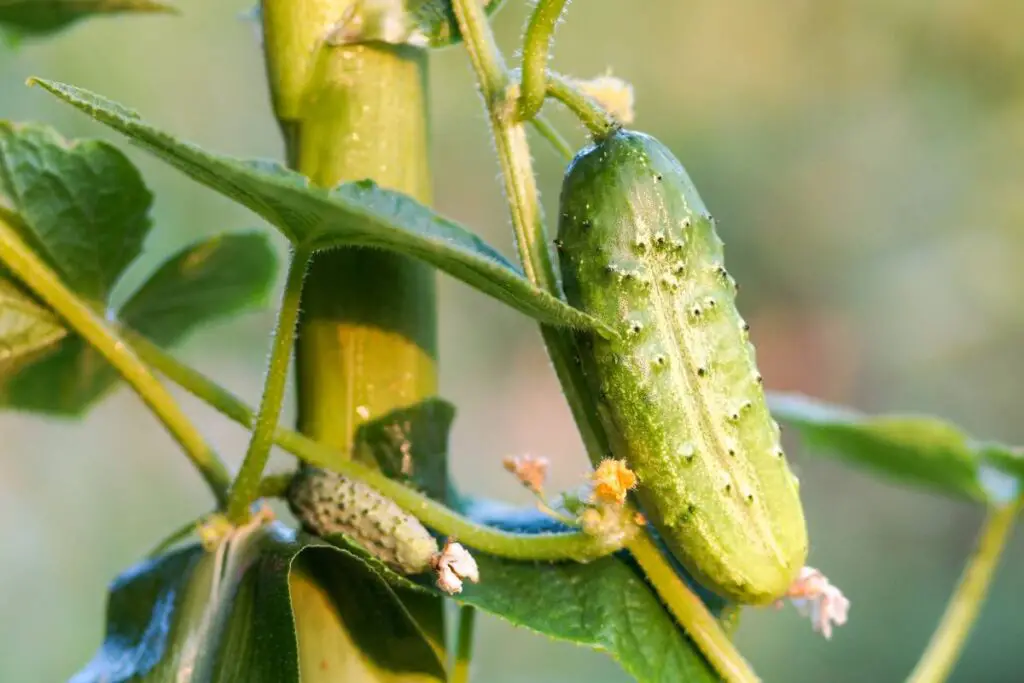
Calculating the cucumber plant count: Sizing up your garden’s cucumber needs
Before you plant the cucumbers in your garden, you need to understand and calculate the number of cucumbers according to your garden’s needs.
First, determine the amount of space your garden can afford to plant cucumbers.
You can usually plant two cucumber plants for every square foot.
If you grow multiple cucumber plants, you must maintain 3 to 4 feet of distance between each plant.
However, many factors determine, such as the cucumber type, the size, the space between the plants, and much more.
If you grow the compact variety, you can also plant four cucumber plants for every square foot.
You must give them enough space to spread out and grow well.
Now, calculate your garden’s square foot and plant the cucumbers accordingly.
Cucumber plants quantity guide: Matching consumption with cultivation
Along with determining the space of your garden, you also need to match the consumption level of the cucumbers with cultivation.
You need to determine the number of cucumbers to plant in your garden depending on the number of cucumbers your household consumes.
There is no exact number of cucumbers to plant based on consumption.
The consumption quantity varies from person to person.
Some people may consume 1 to 2 cucumbers per day, while others may consume 1-2 cucumbers weekly.
So, plant 1-2 plants per person.
Based on this, determine and plant the number of cucumbers according to the family size.
Factors to consider while determining the number of cucumbers for your garden
One cucumber plant is enough to feed one person throughout the summer. But several factors will be taken into consideration.
When you decide to plant cucumbers in your garden, you must consider these factors and then calculate the ideal plant numbers for your garden:
Cucumber consumption habits
When you decide on planting cucumber plants, the number of plants depends on the consumption habits of you and your family.
For example, if you consume one cucumber daily, plant 1-2 plants per person.
Also, consider your preference; whether you want to eat them raw or add them to salads and sandwiches, or you want to make pickles.
To grow a pickling variety, grow the number of plants based on how many pickles you want to make.
One pickling variety can produce around 15 to 20 fruits, or more, based on the variety.
Grow an average of 3 to 4 plants for each quarter of the cucumbers you plan to pickle.
If you eat salads or sandwiches regularly, planting 1-2 plants per person can provide enough supply for daily or 2-3 times per week consumption.
Family size and members
The number of cucumber plants to plant also depends on your family size.
If you consume one cucumber daily, grow 1 to 2 plants per person.
If one plant produces only 15-20 fruits, 2 plants would be enough per person.
Grow 4 to 6 plants for a family of four and 6 to 8 plants for a family of 6.
In this, you must adjust the number of plants you need for your family.
Suppose the whole family consumes only 2 to 4 cucumbers per week.
In that case, you can grow fewer plants than the recommended one.
Here is a small table to help you with the average number of plants your family needs based on the number of family members:
| No. of family members | Average no. of plants based on consumption |
|---|---|
| 2 members | 2 to 4 cucumber plants |
| 4 members | 4 to 8 plants per person |
| 6 members | 6 to 12 plants per person |
| 8 members | 8 to 16 plants per person |
The values in the table are roughly estimated.
The figures may vary based on consumption habits, garden space, and user preferences.
Looking for gardening supplies? We have tested 100's of products before recommending them to you guys. Check out our best pick below:
| Image | Gardening Supplies | Best Price? |
|---|---|---|
 Top
Top Top
Top | Raised Garden Bed Kit | Check On Amazon |
 | XLUX Soil Moisture Meter, Plant Water Monitor, Soil Hygrometer Sensor for Gardening, Farming, Indoor and Outdoor Plants, No Batteries Required | No Results |
 Top
Top Top
Top | 82 Pcs Garden Tools Set and Extra Succulent Tools Set | Check On Amazon |
 | Joeys Garden Expandable Garden Hose with 8 Function Hose Nozzle, Lightweight Anti-Kink Flexible Garden Hoses, Extra Strength Fabric with Double Latex Core, (50 FT, Black) | No Results |
 Top
Top Top
Top | Dual Chamber Compost Tumbler | Check On Amazon |
 Top
Top Top
Top | Sunnyglade Plant Stakes | Check On Amazon |
 Top
Top Top
Top | Organic Cold Pressed Neem Seed Oil | Check On Amazon |
 Top
Top Top
Top | Mighty Mint Gallon :-Insect and Pest Control Peppermint Oil | Check On Amazon |
 Top
Top Top
Top | Scotts DiseaseEx Lawn Fungicide | Check On Amazon |
 Top
Top Top
Top | Jacks Classic 20-20-20 All Purpose Fertilizer | Check On Amazon |
 Top
Top Top
Top | 30,000 Seeds Pollinator Attracting Wildflower Mixture | Check On Amazon |
 Top
Top Top
Top | Survival Vegetable Seeds Garden Kit-Over 16,000 Seeds | Check On Amazon |
Space availability and gardening goals
The space in your garden also determines the number of plants to grow.
Per square foot, you can grow almost 2 to 4 plants.
Based on this, evaluate the space in your garden and then decide the number of plants to grow.
The gardening goals mean what you want to do with these cucumbers: whether you want to eat them raw daily in salads and sandwiches or you want them to preserve and make pickles to store for the long term.
I grow slicing cucumbers.
So, I prefer eating them raw with salads and sandwiches regularly.
My family consists of four members. We grow 4 to 6 plants, which is more than enough for us.
Cucumber varieties
Cucumbers have a crawling habit, and their vines can take up a lot of space in your garden.
So, you must consider the cucumber variety and the garden’s space while planting them.
The vining varieties, especially, take up a lot of space.
Once the vines start growing, you cannot control them much.
On the contrary, the bush varieties are compact.
They stop growing after a certain length.
So, also evaluate the space of your garden and the number of plants you want to have based on the variety you want.
Estimating the cucumber plant quantity based on yield per plant
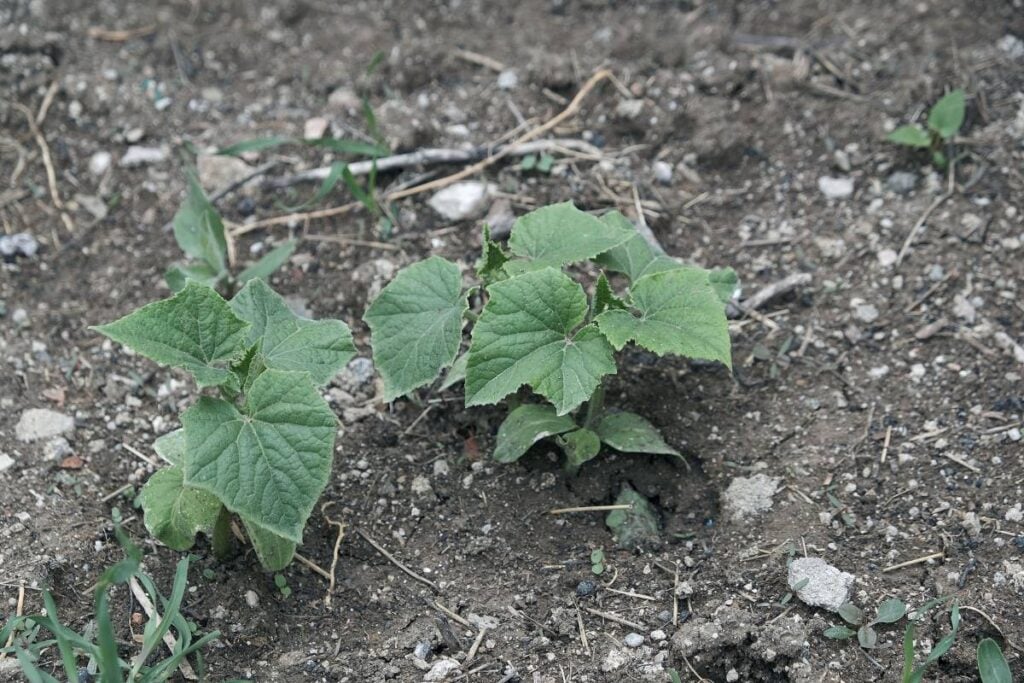
On average, a healthy cucumber plant can have a considerable amount of cucumbers in the growing season.
Some experts have suggested that one plant can produce around 15 to 20 fruits.
The number of yields can be more or less.
It depends on several factors, like the variety, the care and maintenance you provide, and the growing conditions.
Remember that cucumbers will produce fruits one time.
After the fruiting is complete, the vine will die.
As a general rule, estimate two plants per person.
It will allow you moderate amounts of cucumbers for consumption.
Along with that, you also get a surplus amount of cucumbers to share and preserve for future use.
Adjust the estimated value based on the consumption habit, family size, and your gardening goals.
Fruits and yield per plant
Here is a small guide about the number of fruits different varieties produce per plant.
Based on this guide, if you want to grow any of the following varieties, you will get an idea of how many plants you need to grow for your family:
| Varieties | Fruits per plant | Yield per plant |
|---|---|---|
| Telegraph | 25 to 30 | 15 to 18 pounds |
| Telegraph improved | 30 to 40 | 18 to 25 pounds |
| La Diva | 30 to 35 | 14 to 18 pounds |
| Marketmore | 40 to 50 | 20 to 25 pounds |
| Sweet success | 35 to 40 | 19 to 23 pounds |
| Crystal Lemon | 45 to 65 | 11 to 16 pounds |
| Burpless tasty | 35 to 45 | 16 to 21 pounds |
| Venlo pickling | 50 to 60 | 6 to 7 pounds |
| Adam Gherkin | 40 to 45 | 4.5 to 6 pounds |
| Parisian Pickling | 45 to 50 | 4 to 5 pounds |
| Bohemia F1 | 50 to 55 | 4.5 to 5.5 pounds |
The yield will vary based on the fruit size and how you plant, grow, and care for them in the future.
The yield can increase if the fruit size is big and reduce if the size is small.
It will also differ if you do not take proper care.
Careless maintenance prevents the plant from reaching the ideal fruit size and number. So, the yield will be less than the recommended one.
Maximizing the cucumber harvest: Growing and caring for cucumber plants
When planting cucumbers in your garden, it’s essential to determine the number you want to grow.
One of the main factors in determining the number of plants is the yield from each plant.
You need to receive enough yields from a plant when you grow one plant per person because you consume cucumbers daily.
Otherwise, you will have a shortage of cucumbers.
Having ample cucumbers from one plant can reduce the number of plants to grow, resulting in less time spent on maintenance.
Below are some practical ways to increase the cucumber yield in your garden:
Ensure proper spacing between the plants
When you plant the cucumbers, maintain a 3 to 4 feet distance between each plant.
If you sow seeds directly, sow them 1 foot apart.
When the seeds germinate, remove the weak seedlings and maintain 3 to 4 feet of distance between each.
Providing plants with enough space to grow without obstructions is beneficial for their development.
A larger area allows for better air circulation and oxygen supply, which are vital for their growth.
When plants don’t have to compete for nutrients, they all get enough resources, leading to a higher yield than usual.
Sow enough seeds
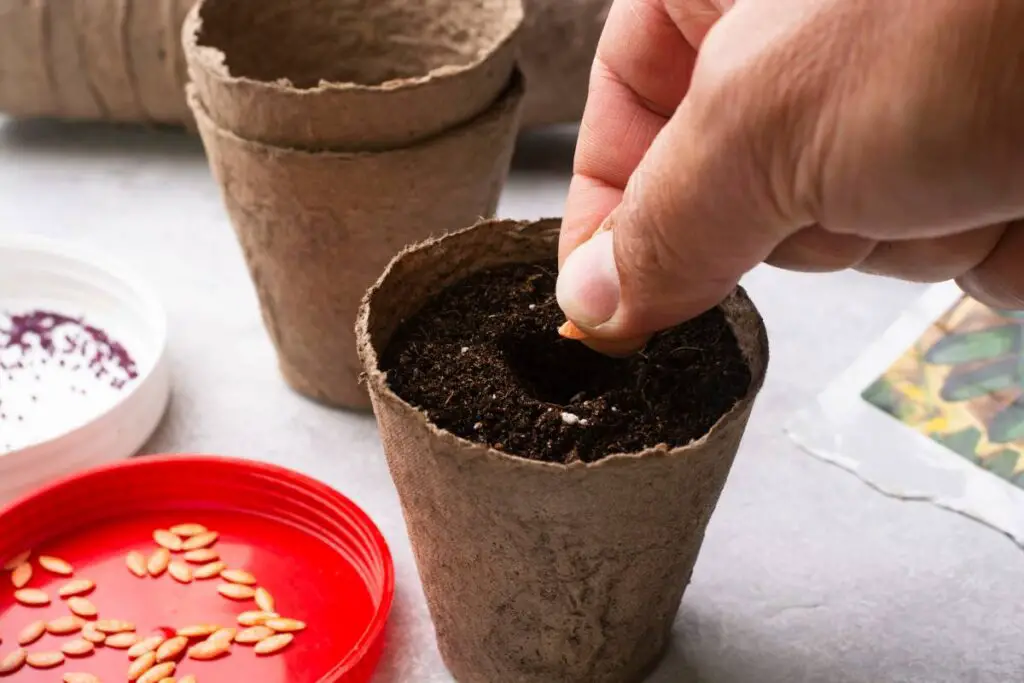
If you plan to grow cucumbers from seeds, sow slightly more seeds than the recommended amount.
After the seeds germinate, some seedlings will grow weak.
You must thin out these weak ones and accept the strong ones to transplant.
If you sow only a few seeds, the number of plants reduces after you remove the weak seedlings.
You will have a shortage of cucumbers.
Usually, the number of plants per person is 1-2. For a family of two, you need 2 to 4 plants.
Sow more than around 6 to 8 seeds.
Thin out the weak ones and collect the strong ones for transplant.
You will receive enough yields to consume, store, and share this way.
Please provide them with adequate sunlight and moisture
Cucumber plants grow best when they receive 6 to 8 hours of sunlight.
Enough sunlight ensures photosynthesis and chlorophyll, encouraging the plant’s development and higher yields.
Cucumbers are 96% moisture. Give them plenty of moisture every day.
The more hydrated the plant remains, the better the yields will be.
Make sure not to overwater or underwater the plants. Otherwise, that will make the plant weak and susceptible to diseases.
Grow them in the right kind of soil
Cucumbers grow best when grown in well-drained nutritious soil.
When you prepare the soil, add organic matter to the soil.
It will make your soil loamy and fertile.
Though cucumbers can grow in any soil, they have a chance of higher yields in nutrient-rich and well-drained soil.
Fertilize them well
Though the nutritious soil provides good yields, fertilizing the plant regularly produces higher yields and healthy cucumbers.
Fertilize the plant with a balanced liquid fertilizer every 2 weeks.
If your plant is healthy, it will respond positively within a few weeks.
You will see plenty of growth, flowers, and fruits.
A healthy plant can provide surplus cucumbers to consume, share, and preserve.
Save from extreme temperatures
Extreme temperatures can affect flowering.
Fewer flowers lead to less pollination, therefore, lesser yields.
To increase the yields, ensure the plant remains protected from extreme temperatures, whether hot or cold.
During the summer afternoons, shade your plant with a cloth to protect them from the intense sunlight.
If the temperature exceeds 90 to 95°F, water your plant enough to keep it cool and hydrated.
Add a thick layer of mulch to help the plant retain moisture in the roots and soil.
During the winters, when the temperature crosses 50-55°F, either take them inside or cover them with row covers or frost blankets.
Add a layer of mulch to prevent the cold, freezing temperature from reaching the roots and affecting them.
Grow them in a trellis
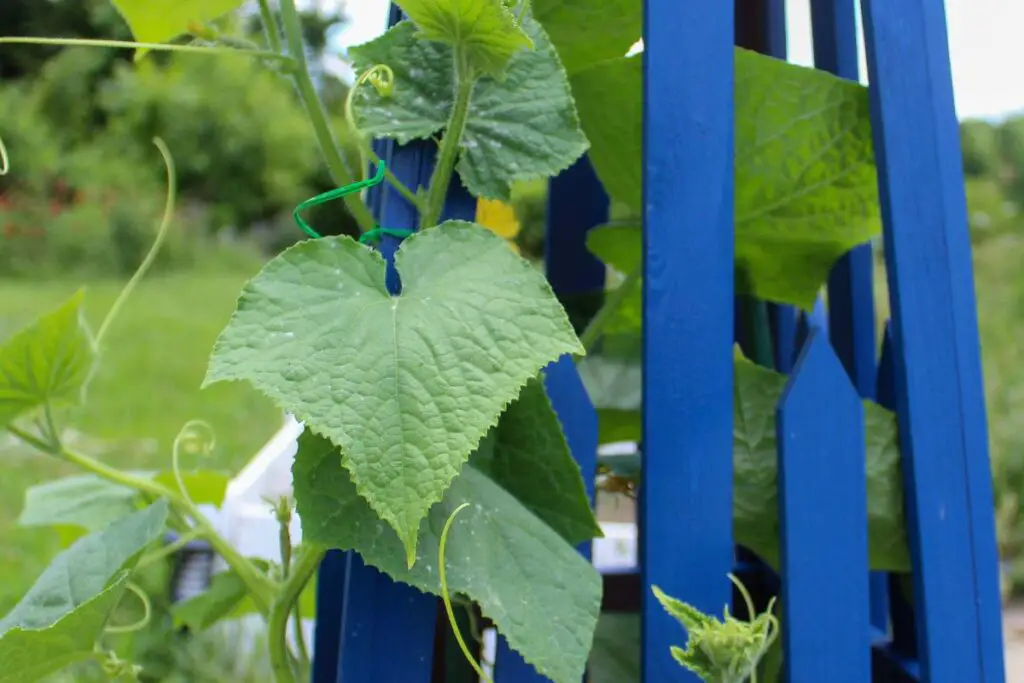
Cucumbers have a crawling habit.
When grown in the ground, they can cover most of the space of your garden.
The bush variety, however, has a compact growth habit.
The vines stop growing after a certain length.
But the default varieties cannot be controlled.
Due to this, you may not be able to grow the estimated number of vining varieties in your garden.
Trellising can provide you with enough space and, thus, allow you to grow the estimated number of plants with the right yields.
Another benefit of trellising is that the plant suffers less from infestation.
On the ground, plants can get affected by pests and soil-borne diseases. The fruits can rot due to overwatering during rains.
When providing requirements or harvesting, you may step on them by mistake and damage the fruits, thus reducing the number of yields.
If the yield reduces, you have a shortage of cucumbers.
With a trellis, the cucumbers will stay above the ground. Therefore, there are no chances of any infestation, rotting, or damage by stepping over them.
Therefore, you receive healthy yields and higher yields than you expect.
In trellis, sow the seeds 4 inches apart, and maintain 6 to 12 inches of distance for transplants.
Ensure good cucumber pollination
You will only receive fruits if the plant has enough pollination.
Without pollination, there are no chances of fruit production.
For pollination, the male flower’s pollen should be carried by the female flowers by natural means like air, wind, and pollinators like bees, butterflies, and other insects.
The monoecious varieties will have both male and female flowers.
But gynoecious have only female flowers.
Pair up some monoecious varieties will gynoecious varieties for cross-pollination and higher yields.
If the plants don’t pollinate through natural means, hand-pollinate them.
Rub the pollen from the male flowers with a paintbrush or cotton swab into the female flower.
Or, break the male flower and rub it with the female flowers.
Do not feel guilty because the male flower will automatically fall off after pollination.
If you have parthenocarpic varieties, don’t worry about pollination.
They do not need to pollinate to produce new fruits.
Pest and disease management
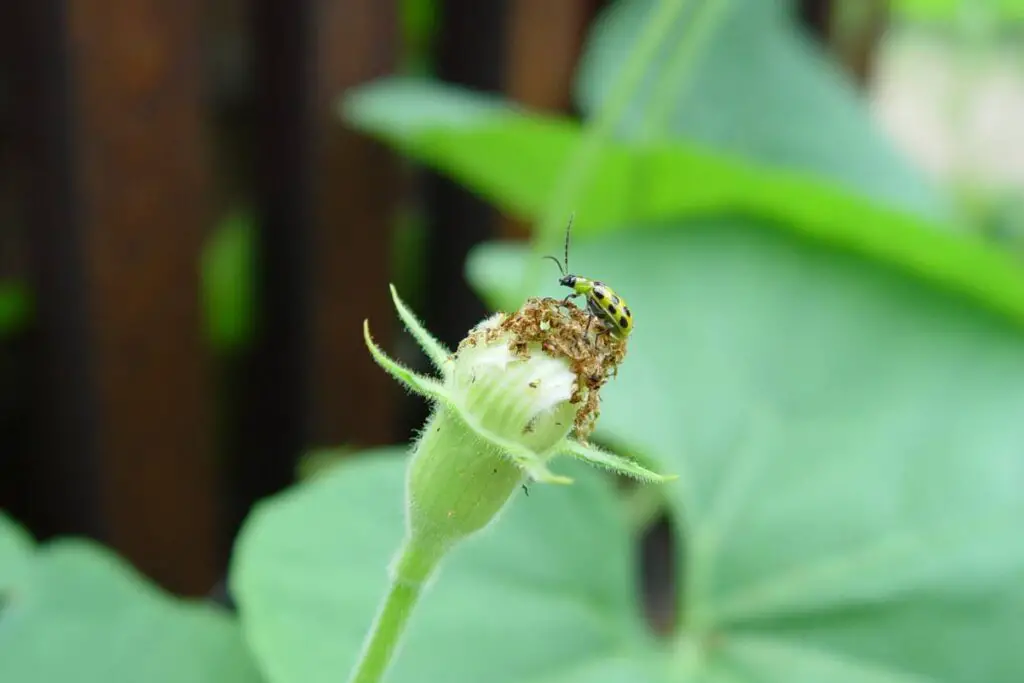
Regularly examine the plant’s condition.
If you find any pest infestation, eliminate them immediately using neem oil, insecticidal soaps, and pesticides.
Introduce beneficial insects.
They will feed on these bugs and make your plant bug-free.
The faster you take action, the quicker you can make your plant healthy as before.
Fast action won’t hinder fruit production and let you have the right yields.
The best way to manage diseases is to prevent them.
Once the plant gets infected, bringing the plant back to being healthy as before becomes challenging.
Consider crop rotation, maintain enough space and air circulation of each plant, and solarize the soil before planting to prevent pests and diseases.
Final thoughts
Whatever variety you choose, growing at least 1 to 2 plants per person is worth growing. This average amount will allow you to enjoy enough cucumbers throughout the summer. The plant count will vary based on the garden space, consumption level, family size, the variety you grow, and gardening goals.
If your garden does not have enough space to grow the estimated number of cucumbers, grow the cucumbers in a trellis. It gives enough space to grow a few more plants. For higher yields, take good care of the plant by providing adequate sunlight, moisture, and fertilization.
Grow them in well-drained, fertile, and loamy soil, and protect them from extreme temperatures. Keep an eye out for pests and take immediate action. Consider crop rotation to prevent diseases. Plant the plants at least 3 to 4 feet apart to let the plants grow freely and encourage adequate air circulation.
How many cucumbers does one plant produce?
There is no exact cucumber quantity from one plant. It depends on the variety, the growing conditions, and the care you provide. However, generally, expect at least 15 to 20 cucumbers per plant.
How do I know when to harvest the cucumbers?
Cucumbers get ready to harvest within 50 to 70 days. When the time arrives, check the cucumbers’ texture and length. The texture will be bumpy or rough based on the variety, the pickling varieties will be 2 to 4 inches, and the slicing will be 8 to 9 inches.
Reference: Cucumber Wikipedia
